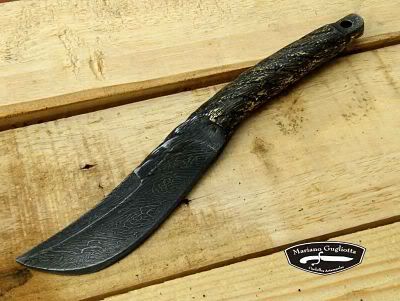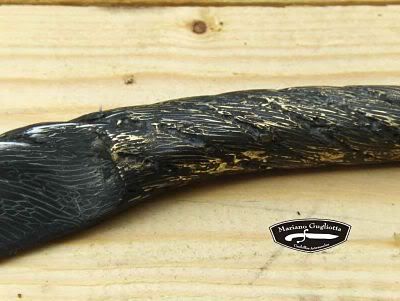Hi folks.
When I started to forge Damascus steel I did it with the cable damascus.
I always thought it was the best way to learn the rhythm of the hand forging and learn about temperature, flux, ect....
Some years ago reading the great book of Ed Fowler, "Knife Talk", I was struck by the part where Ed talks about including bronze in the cable damascus.
So I started using it, but only into the handle.
So ... I will not bore you more ![]() . Here you can see some videos where I show a little of the hand forging technique ideal to begin forging cable damascus and another on how insert bronze in the handle.
. Here you can see some videos where I show a little of the hand forging technique ideal to begin forging cable damascus and another on how insert bronze in the handle.



[media] http://www.youtube.c...h?v=_0cpV0QtVOo [/media]
please be very careful when handling the molten bronze can be really dangerous
[media] http://www.youtube.c...h?v=juBigrOAFFw [/media]
Mariano Gugliotta
Mariano: Thank you for your kind comments about my early experimenting with Wire Damascus.
There was a time when I did a lot of experimenting with Wire Damascus. This experiment started with a poorly welded blade with many black voids. Looking at it I remembered a time of my youth seeing god in the rock formation of a mine I was working in. I first felt this could be an exceptionally beautiful blade if I could braze it with brass and should the brass be retained in the voids of the poorly welded blade it could resemble gold in that rock formation. This would not only save a poorly welded blade but could result in a beautiful blade, I hoped this process would prove out to be a method to improve performance as well as beauty.
There was a time when we believed that layered Damascus steel was capable of higher performance than the available steels used to forge blades. It was only through controlled performance testing that we learned that this was not the case. Damascus is pretty, but cannot out perform a well forged blade with a well planned heat treat.
I felt that Wire Damascus was an opportunity for the blade smith to alloy hos own blades to greater levels through the greater porosity of the metal due to the many welds in a forged welded wire blade. Hopefully these welds (porosity) would accept alloys in the areas of the welds and influence the adjacent metal (strands). (seemed like a good idea at the time)
I tried several brazing materials and was offered some help from an outfit that supp-lied brazing materials in that they would allow me to purchase single rods rather than the usual minimum order they would accept.
About this time I started working with 52100 steel and never looked back.
For those of yo who wish to experiment I invite you to try various materials and compare the visual beauty you can develop and also strongly suggest that you evaluate each alloy on the basis of performance.
I believe this process has potential, all it needs is some attention from those who want to try.
Ed You are one of the most inspiring bladesmiths that I know.
I always enjoy reading your books back and watch your DVDs again and again. Even bought a black Labrador as the one in the book <img src=' http://www.americanbladesmiths.com/ipboard/public/style_emoticons//laugh.gi f' class='bbc_emoticon' alt=':lol:' />
It is good to read you on this forum and I will soon to return to the KTO Forum Tuesday's chat.
Saludos
Mariano
Mariano Gugliotta
Thank you Mariano: It will be good times having you visit chat next Tuesday.
You did a real nice job with those videos, I appreciate your sharing what you have learned in this manner, sure beats trying to type it all out.

